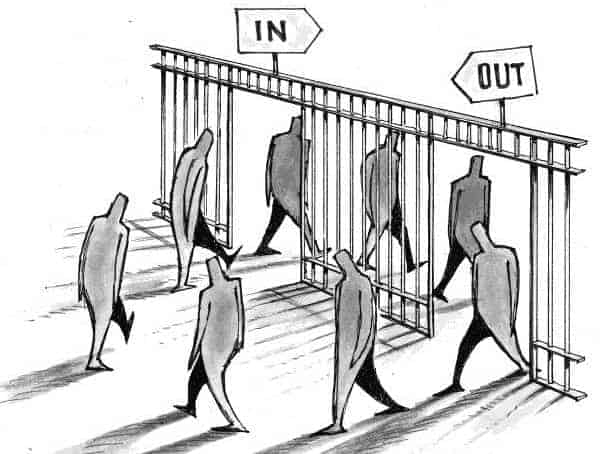The Cuts So Far (Part 5): Corrections – The high cost of quitting prison drug rehab ‘cold turkey’
Over the past two years, the Wyoming State Legislature has cut hundreds of millions of dollars from state agencies and public services in response to declining mineral revenues. In this multi-part series, “The Cuts So Far,” Better Wyoming will give readers a sense of some of these cuts’ magnitude and impacts in advance of the 2018 Legislative budget session.
Up until recently, Wyoming had a pretty good prison “recidivism rate” (the rate at which folks who are released from prison get sent back there because of subsequent offenses). Nationwide, roughly four in 10 former inmates get locked up again after being released. But Wyoming’s recidivism rate was less than 25 percent, second in the nation only to Oregon.
The state was so proud of this accomplishment that lawmakers commissioned a report to show other states what a great job Wyoming was doing. The report, published in December 2016, highlighted the role of substance abuse treatment as a key to success.
“The connection between drug and alcohol use and crime is well documented,” the report stated. “According to Wyoming Corrections officials, substance abuse is the single most common factor among all persons in the correctional system.”
But before report’s ink had even dried, the Wyoming State Legislature voted to cut more than $4 million from the Department of Correction’s prison substance abuse programs. As a result, the DOC laid off 27 therapists and support staff, essentially eliminated outpatient drug and alcohol counseling for inmates, and severely reduced the number of beds available for inpatient treatment.
Unsurprisingly, Wyoming’s recidivism rate spiked as a result. Prisoners are no longer being treated for substance abuse problems, so, once they’re released, they’re ending up right back inside.
Instead of showing off Wyoming’s success, that report now offers a cautionary tale for reckless legislators looking to save a few bucks.
When budget cuts are no longer “fiscally conservative”
Lawmakers tend to cut budgets in the name of being “fiscally conservative.” (Or, they do so to appear fiscally conservative, anyway.)
But just like the Legislature’s cuts to highway repair funding are going to end up costing Wyoming more in the long run, cuts to the DOC’s substance abuse programs have made prison cost more, as well.
In the one year since the cuts took place, the state’s correctional system has already seen a 7 percent increase in people who fail the conditions of their release because of substance abuse issues. That means about 112 people ended up back behind bars last year, at a cost of $113 a day per inmate.
At that rate, Wyoming will wind up spending about $9 million for these additional inmates during 2017-18 biennium—more than twice the amount lawmakers “saved” by cutting the substance abuse programs. DOC Director Bob Lampert told the Joint Appropriations Committee that if left unchecked, the Legislature’s action will only result in more wasted money and more inmates returning to prison after their release.
So much for being “fiscally conservative.”
Substance abuse treatment is a clear need
There has never been a doubt that Wyoming prisoners need substance abuse treatment. The Wyoming DOC says roughly half of the state’s inmates need residential substance abuse treatment, and about 20 percent will also require intensive outpatient treatment when they are released.
For years Wyoming made a wise investment in treating inmates for drug addictions. In 1987 Gov. Mike Sullivan created the Governor’s Drug Policy Board, which consisted of representatives from law enforcement, corrections, and healthcare communities. In 1998, the Legislature approved $3.2 million to implement a prison substance abuse pilot project. Lawmakers added $5.2 million the next year for an initiative to combat methamphetamine addiction.
But despite its success, funding for DOC’s program peaked at $11.3 million in 2011-12 and fell to $7.9 million by 2015-16. The program bottomed out with the $4.1 million cut for 2017-18.
Advocates for the most recent cuts, like Rep. Bob Nicholas (R-Cheyenne), tend to take a tough-on-crime stance to augment their “fiscally conservative” arguments:
“The average person in Wyoming would rather see roads fixed, education funded properly, and monies going to local governments and things like that, rather than spending money on rehab for inmates in Rawlins,” Nicholas told WyoFile.
But Nicholas, the chairman of the House Appropriations Committee, backed off last month and joined Gov. Matt Mead in support of restoring substance abuse funds. It remains to be seen whether the rest of the Legislature follows their lead.
“Trimming the fat” or gutting good programs?
Over the past two years, the Legislature has cut about $22 million from the Department of Corrections’ budget—much more than just prison substance abuse programs.
The DOC perennially struggles with staffing, but recent cuts have prompted the agency to freeze hiring for 169 positions—mostly correctional officer slots—and shift roughly $17 million to fund overtime expenditures for the overworked staff it does have.
In a statement to Better Wyoming, DOC officials responded to a request about the impact of budget cuts:
“Budget cuts have impacted the overall agency. Reduced funding for things such as travel, equipment and day-to-day operations made it necessary to do more with less in order to continue providing for public safety and offender rehabilitation. We have been looking for less costly ways to provide additional basic treatment services to those we house, and additional staff have been asked to step up to help fill the void as we continue our mission with limited programming.”
This is hardly the first time a Wyoming state department has been asked to do more with less. But it’s also part of a disturbing trend taking place in Wyoming where, more and more often, “fiscally conservative” lawmakers are cutting department budgets so deeply that they’re no longer “trimming the fat”—they’re gutting successful programs that function for the benefit of all of us.
It’s also becoming clear that many of these lawmakers are more concerned with the political benefits of appearing “fiscally conservative” than they are with actually serving the people of Wyoming’s best interests.
Sign up for Better Wyoming emails on our homepage and follow us on Facebook and Twitter. [one_third last=”yes” spacing=”yes” center_content=”no” hide_on_mobile=”no” background_color=”” background_image=”” background_repeat=”no-repeat” background_position=”left top” border_position=”all” border_size=”0px” border_color=”” border_style=”solid” padding=”” margin_top=”” margin_bottom=”” animation_type=”0″ animation_direction=”down” animation_speed=”0.1″ class=”tomoveSidebar” id=””][tagline_box backgroundcolor=”” shadow=”no” shadowopacity=”0.7″ border=”1px” bordercolor=”” highlightposition=”top” content_alignment=”left” link=”” linktarget=”_self” modal=”” button_size=”” button_shape=”” button_type=”” buttoncolor=”” button=”” title=”THE CUTS SO FAR
Read the rest” description=”” margin_top=”” margin_bottom=”” animation_type=”0″ animation_direction=”down” animation_speed=”0.1″ class=”” id=””]
Read the other articles in our “Cuts So Far” series
Part 2: Healthcare – Living (and dying) within our means
Part 3: University of Wyoming – College dazed
Part 4: WyDOT – It’s going to be a bumpy ride
Part 5: Corrections – The high cost of quitting drug rehab ‘cold turkey’
Part 6: Game and Fish – Hunting for funding
Part 7: Public Schools – No more pencils, no more books, no more teachers
[/tagline_box][/one_third]







Comments are closed.